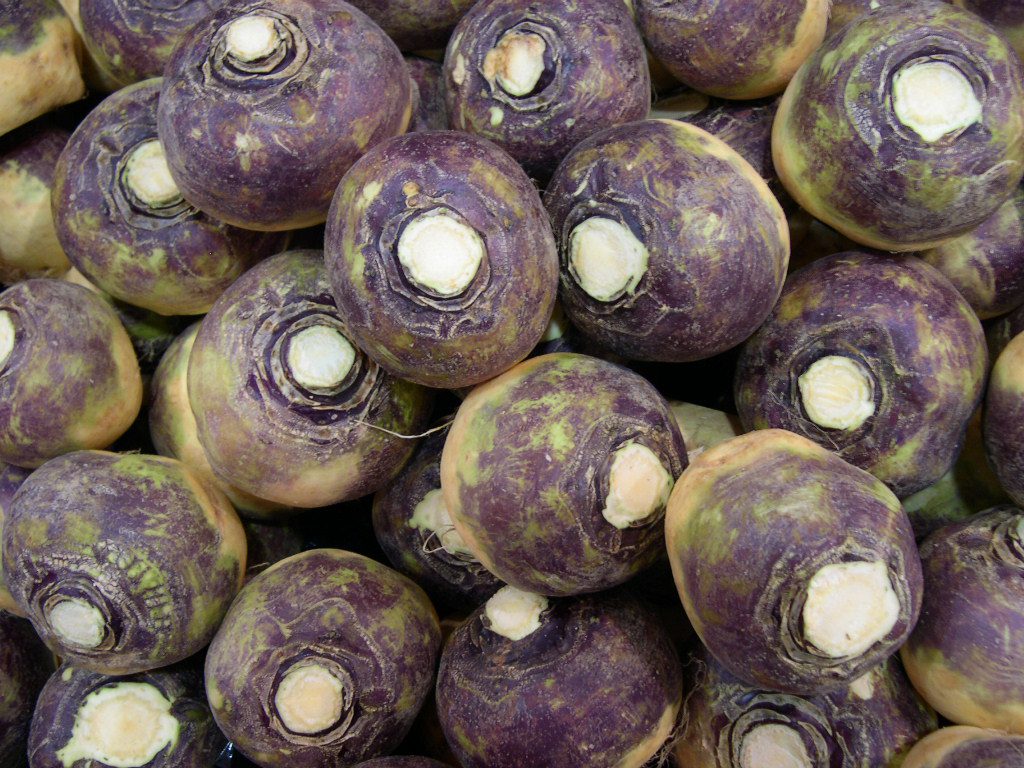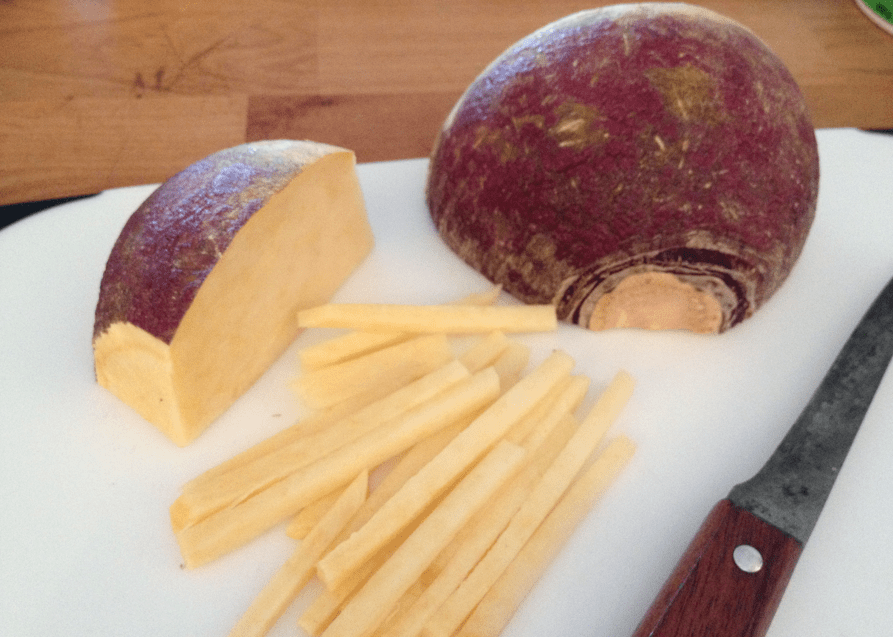If you’re a dog parent who loves providing your furry friend with healthy treats, you might be wondering if rutabagas are safe for your pup’s consumption.
These root vegetables are known for their unique taste and impressive nutrient profile, but can dogs join in on the fun?
In this article, we’ll explore whether or not dogs can eat rutabaga and what benefits this veggie can offer for your pup’s overall health. So, grab a snack (for you, not your dog), and let’s dive in!
- Can Dogs Eat Rutabaga?
- How Many Rutabaga Can Dogs Eat?
- How Often Can Dogs Eat Rutabaga
- Health Benefits of Rutabaga To Dogs
- Potential Risks of Feeding Rutabaga To Dogs
- Nutritional Benefits of Rutabaga For Dogs
- Are Dogs Sensitive To Rutabaga?
- How To Prepare Rutabaga For Dogs
- How Fast Will Dogs Digest Rutabaga?
- In Conclusion
Can Dogs Eat Rutabaga?

Yes, dogs can safely eat raw and cooked rutabaga as long as it’s given to them in moderation and prepared properly.
Rutabaga is a healthy vegetable that is low in calories and high in fiber, vitamin C, and potassium.
However, it is important to note that feeding your dog too much rutabaga can result in digestive issues, such as gas or diarrhea.
Additionally, some dogs may be allergic to rutabaga or other cruciferous vegetables, so it is always best to introduce new foods to your dog’s diet gradually, starting with small amounts and monitoring for any adverse reactions.
As always, consult with your veterinarian before making any significant changes to your dog’s diet.
See also: 47 Safe Vegetables To Feed Your Dog. Puppy Power!
How Many Rutabaga Can Dogs Eat?

The amount of rutabaga that a dog can eat depends on their size and dietary needs.
As a general rule, dogs can have rutabaga in moderation as a healthy addition to their diet.
A small dog can tolerate half a teaspoon to one teaspoon of mashed rutabaga as a treat, while a larger dog may be able to eat up to one or two tablespoons.
However, it is important to remember to introduce rutabaga to your dog’s diet slowly, starting with small amounts and monitoring for any digestive issues or allergic reactions.
As always, consult with your veterinarian for specific recommendations on your dog’s diet.
Rutabaga Feeding Chart According To Size
| Food | Size | Portion |
|---|---|---|
| Rutabaga | Toy dogs | half rutabaga |
| Rutabaga | Small dogs | half rutabaga |
| Rutabaga | Medium dogs | one rutabaga |
| Rutabaga | Large Dogs | one rutabaga |
Rutabaga Feeding Chart According To Age
| Food | Age | Portion |
|---|---|---|
| Rutabaga | 0 – 6 months | Don’t feed |
| Rutabaga | 6 – 12 months | half rutabaga |
| Rutabaga | 12 – 24 months | one rutabaga |
| Rutabaga | 24+ months | one rutabaga |
How Often Can Dogs Eat Rutabaga
Dogs can eat rutabaga in moderation as a healthy addition to their diet but it should not be a regular part of their daily diet.
It is recommended to offer rutabaga as an occasional treat or supplement to their regular meals.
You can try offering rutabaga once or twice a week, in small amounts, to see how your dog reacts to it.
As always, it’s important to monitor your dog’s digestion and overall health and consult with your veterinarian before making any significant changes to their diet.
Health Benefits of Rutabaga To Dogs
- Lowers the risk of obesity. Rutabaga is low in calories and high in fiber, making them a great healthy snack option for dogs who are overweight or have a tendency to gain weight. The fiber in rutabaga can also help your dog feel more satisfied and full.
- Boosts digestive health. Rutabaga is high in fiber, which can support healthy digestion in dogs. Fiber helps keep things moving along in their intestines, preventing constipation and promoting regular bowel movements.
- Supports immune system function. Rutabaga is a great source of vitamin C, which is essential for immune system function in dogs. Vitamin C can help protect against illness and disease, as well as support overall health and well-being.
- Promotes healthy skin and coat. Rutabaga is a good source of vitamin C, which is known for its skin-healing properties. Vitamin C can help improve your dog’s coat condition, making it softer, shinier, and stronger.
- Provides natural energy. Rutabaga is a great source of potassium, which can help provide natural energy to dogs. This can be especially beneficial for active dogs, those who are training, or those who need an extra boost of energy.
- Lowers the risk of heart disease. Rutabaga is a low-fat vegetable that can help lower the risk of heart disease in dogs. Its high fiber content may also help reduce levels of “bad” cholesterol in the blood.
- Supports overall health and well-being. Rutabaga is a nutrient-dense vegetable that provides a variety of health-promoting vitamins and minerals to dogs. Incorporating rutabaga into your dog’s diet can help support overall health and well-being, promoting a longer and healthier life.
Potential Risks of Feeding Rutabaga To Dogs
- Digestive Issues. While rutabaga can be a healthy addition to your dog’s diet, it also contains a high level of fiber. Offering too much rutabaga can cause digestive issues such as bloating, gas, and diarrhea.
- Allergic reactions. Some dogs may be allergic to rutabaga or other cruciferous vegetables. Signs of an allergic reaction can include itching, facial swelling, diarrhea, and vomiting. If your dog has an allergic reaction, stop feeding them rutabaga immediately, and seek veterinary care if needed.
- Interference with digestion. Rutabaga contains a compound called thiocyanate, which may interfere with iodine uptake in the thyroid gland, leading to hypothyroidism. Dogs that have hypothyroidism or are receiving thyroid medication should consume rutabaga in moderation, or avoid it altogether.
- Intestinal blockages. Rutabaga may cause intestinal blockages in dogs if not cut into small, digestible pieces. Dogs who are prone to eating quickly or have a habit of swallowing large chunks of food without chewing should be supervised when eating rutabaga.
- Imbalance of nutrients. While rutabaga contains many beneficial vitamins and minerals, feeding it in excess can lead to an imbalance of nutrients in your dog’s diet. This is why it’s important to offer it as an occasional supplement rather than a regular part of their meals.
Nutritional Benefits of Rutabaga For Dogs
| Rutabaga Nutrition Facts per 100 grams | % DV * |
|---|---|
| Calories | 38 |
| Total Fat | 0.2 g |
| Cholesterol | 0 mg |
| Sugar | 4.5 g |
| Glycemic Index | 72 |
| Sodium | 12 mg |
| Carbs | 9 g |
| Protein | 1.1 g |
| Vitamin C | 41% |
| Calcium | 4% |
| Iron | 2% |
| Potassium | 305 mg |
Are Dogs Sensitive To Rutabaga?
Yes, some dogs can be sensitive to rutabaga or other cruciferous vegetables. Sensitivity symptoms may include itching, skin irritation, diarrhea, vomiting, and gastrointestinal upset.
In some cases, feeding your dog too much rutabaga can also cause digestive issues like bloating, gas, and diarrhea.
If you suspect that your dog may be sensitive to rutabaga, it’s important to introduce it to their diet slowly and monitor their reaction.
If they show signs of sensitivity, stop feeding them rutabaga and consult with your veterinarian for advice.
How To Prepare Rutabaga For Dogs
Cooked and Mashed
One of the best ways to prepare rutabaga for dogs is by cooking and mashing it. Rinse the rutabaga thoroughly, peel it, chop it into small pieces, and boil it until it’s tender.
Once cooked, mash it up using a fork or potato masher until it’s a smooth and consistent texture. Add a small amount of salt and pepper for taste, or mix it with your dog’s regular food.
Raw and Shredded
Another option is to prepare rutabaga raw and shredded, as it may offer additional nutritional benefits. Rinse the rutabaga thoroughly, peel it, and use a grater to shred it finely.
Serve it fresh as a tasty snack or mix it with your dog’s regular food. Remember to introduce raw food slowly and in small amounts to your dog’s diet to avoid any digestive issues.
Baked in Treats
If your dog loves treats, using rutabaga in baked goods like cookies, muffins, or even dog biscuits can be a great way to introduce this vegetable into their diet.
Mix cooked and mashed rutabaga into batter recipes, or chop raw rutabaga and add it to a homemade biscuit recipe. Just keep in mind, that these treats should be given in moderation and should not replace their regular meals.
How Fast Will Dogs Digest Rutabaga?
Dogs may digest rutabaga at different rates depending on their individual digestive system and size.
Generally, dogs’ digestive systems are quite efficient, and they are able to digest and absorb nutrients from food quite quickly.
After eating rutabaga, dogs may start to digest it within a few hours. However, the exact time it takes for dogs to digest rutabaga can vary based on various factors such as age, health status, and diet.
It’s important to monitor your dog’s digestion after eating rutabaga to ensure they are not experiencing any digestive issues or uncomfortable symptoms.
If you are concerned about how fast your dog is digesting rutabaga, consult with your veterinarian.
In Conclusion
In conclusion, dogs can eat rutabaga in moderation, as a healthy and nutritious addition to their diet.
Rutabaga is low in calories and high in fiber, vitamin C, and potassium, providing many health benefits such as lower risk of obesity, boosted digestive health, improved immune system function, and healthy skin and coat.
However, it is essential to introduce rutabaga to your dog’s diet slowly and in moderation, as too much of it can cause digestive issues, allergic reactions, and other potential risks such as interference with iodine uptake in the thyroid gland.
It’s also essential to consult with your veterinarian before introducing any new food to your dog’s diet, to ensure they are receiving the proper nutrients they need and to prevent any adverse reactions.
Other vegetables that dogs can consume include Asparagus, Beets, Bell peppers, Bok choy, Broccoli, Brussels sprouts, Butternut squash, Cabbage, Carrots, Cauliflower, Celery, Chicory, Cucumber, Eggplant, Green beans, Jicama, Kale, Edamame, Lettuce, Mushrooms (safe types), Okra, Parsnips, Peas, Pumpkin, Radicchio, Radishes, Spinach, Spaghetti squash, Sweet potato, Swiss chard, Tomatoes, Turnips, Water chestnuts, Yellow squash, Zucchini, Artichoke, Arugula, Collard greens, Dandelion greens, Endive, Fennel, Ginger, Black-eyed peas, Cardoon, Bamboo shoots, Bean sprouts, Beetroot, Celeriac, Chickpeas, Kohlrabi, Lentils, Mung Beans, Mustard Greens, Potatoes.





Leave a Reply